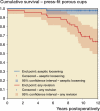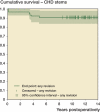Cementless total hip arthroplasty in patients with severely dysplastic hips and a previous Schanz osteotomy of the femur: techniques, pitfalls, and long-term outcome
- PMID: 19421907
- PMCID: PMC2823216
- DOI: 10.3109/17453670902967273
Cementless total hip arthroplasty in patients with severely dysplastic hips and a previous Schanz osteotomy of the femur: techniques, pitfalls, and long-term outcome
Abstract
Background and purpose: Historically, a Schanz osteotomy of the femur has been used to reduce limp in patients with severely dysplastic hips. In such hips, total hip arthroplasty is a technically demanding operation. We report the long-term results of cementless total hip arthroplasty in a group of patients who had all undergone a Schanz osteotomy earlier.
Patients and methods: From 1988 through 1995, 68 total hip replacements were performed in 59 consecutive patients previously treated with a Schanz osteotomy. With the cup placed at the level of the true acetabulum, a shortening osteotomy of the proximal part of the femur and distal advancement of the greater trochanter were performed in 56 hips. At a mean of 13 (9-18) years postoperatively, we evaluated these patients clinically and radiographically.
Results: The mean Harris hip score had increased from 51 points preoperatively to 93 points. Trendelenburg sign was negative and there was good or slightly reduced abduction strength in 23 of 25 hips that had not been revised. There were 12 perioperative complications. Only 1 cementless press-fit porous-coated cup was revised for aseptic loosening. However, the 12-year survival rate of these cups was only 64%, as 18 cups underwent revision for excessive wear of the polyethylene liner and/or osteolysis. 6 CDH femoral components had to be revised due to technical errors.
Interpretation: Our results suggest that cementless total hip arthroplasty combined with a shortening osteotomy of the femur and distal advancement of the greater trochanter can be recommended for most patients with a previous Schanz osteotomy of the femur. Because of the high incidence of liner wear and osteolysis of modular cementless cups in this series, nowadays we use hard-on-hard articulations in these patients.
Figures




Similar articles
-
Cementless total hip arthroplasty in patients with high congenital hip dislocation.J Bone Joint Surg Am. 2006 Jan;88(1):80-91. doi: 10.2106/JBJS.E.00037. J Bone Joint Surg Am. 2006. PMID: 16391252
-
Cementless Total Hip Arthroplasty Involving Trochanteric Osteotomy without Subtrochanteric Shortening for High Hip Dislocation.Clin Orthop Surg. 2017 Mar;9(1):19-28. doi: 10.4055/cios.2017.9.1.19. Epub 2017 Feb 13. Clin Orthop Surg. 2017. PMID: 28261423 Free PMC article.
-
Cementless total hip arthroplasty for severely dislocated hips previously treated with Schanz osteotomy of the proximal femur.Arch Orthop Trauma Surg. 2018 Mar;138(3):427-434. doi: 10.1007/s00402-018-2879-z. Epub 2018 Feb 2. Arch Orthop Trauma Surg. 2018. PMID: 29396634
-
[Hip arthroplasty after corrective osteotomies : Pelvis and proximal femur].Orthopade. 2016 Aug;45(8):678-86. doi: 10.1007/s00132-016-3294-1. Orthopade. 2016. PMID: 27385386 Review. German.
-
[Use of dual mobility cups for revision hip arthroplasty].Orthopade. 2017 Feb;46(2):114-120. doi: 10.1007/s00132-016-3383-1. Orthopade. 2017. PMID: 28097416 Review. German.
Cited by
-
Surgical technique: The capsular arthroplasty: a useful but abandoned procedure for young patients with developmental dysplasia of the hip.Clin Orthop Relat Res. 2012 Nov;470(11):2957-67. doi: 10.1007/s11999-012-2444-y. Clin Orthop Relat Res. 2012. PMID: 22733187 Free PMC article.
-
Step-Cut Subtrochanteric Osteotomy Combined with Total Hip Arthroplasty for Neglected Traumatic Hip Dislocations.Clin Orthop Surg. 2022 Jun;14(2):205-212. doi: 10.4055/cios21104. Epub 2022 Apr 13. Clin Orthop Surg. 2022. PMID: 35685975 Free PMC article.
-
Long-term clinical comparison of three different femoral stems in Total Hip Arthroplasty with femoral shortening in patients with high-riding hips.J Orthop Surg Res. 2025 May 17;20(1):479. doi: 10.1186/s13018-025-05889-8. J Orthop Surg Res. 2025. PMID: 40382662 Free PMC article.
-
The effect of previous pelvic or proximal femoral osteotomy on the outcomes of total hip arthroplasty in patients with dysplastic coxarthrosis.Acta Orthop Traumatol Turc. 2020 Jan;54(1):74-82. doi: 10.5152/j.aott.2020.01.7. Acta Orthop Traumatol Turc. 2020. PMID: 32175900 Free PMC article.
-
Uncemented total hip arthroplasty in osteoarthritis of hip secondary to low and high dislocated hips: A mid-term follow-up study.J Nat Sci Biol Med. 2016 Jul-Dec;7(2):136-42. doi: 10.4103/0976-9668.184699. J Nat Sci Biol Med. 2016. PMID: 27433063 Free PMC article.
References
-
- Brooker AF, Bowerman JW, Robinson RA, Riley LH. Ectopic ossification following total hip replacement. Incidence and a method of classification. J Bone Joint Surg (Am) 1973;55:1629–32. - PubMed
-
- Carlsson A, Bjorkman A, Ringsberg K, von Schewelov T. Untreated congenital and posttraumatic high dislocation of the hip treated by replacement in adult age: 22 hips in 16 patients followed for 1-8 years. Acta Orthop Scand. 2003;74:389–96. - PubMed
-
- Charnley J, Cupic Z. The nine and ten year results of the low-friction arthroplasty of the hip. Clin Orthop. 1973;(95):9–25. - PubMed
-
- Charnley J, Feagin JA. Low-friction arthroplasty in congenital subluxation of the hip. Clin Orthop. 1973;(91):98–113. - PubMed
-
- Eftekhar N. Principles of total hip arthroplasty. CV Mosby. St Louis. 1978:437–55.
Publication types
MeSH terms
LinkOut - more resources
Full Text Sources
Medical
